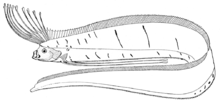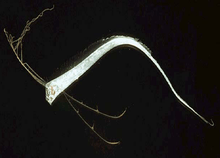Giant oarfish
The giant oarfish (Regalecus glesne) is a species of oarfish of the family Regalecidae. It is an oceanodromous species with a worldwide distribution, excluding polar regions. Other common names include Pacific oarfish, king of herrings, ribbonfish, and streamer fish.[1]
| Giant oarfish | |
|---|---|
 | |
| A taxidermied specimen of Regalecus glesne in Naturhistorisches Museum Wien. | |
| Scientific classification | |
| Kingdom: | |
| Phylum: | |
| Class: | |
| Order: | |
| Family: | |
| Genus: | |
| Species: | R. glesne |
| Binomial name | |
| Regalecus glesne Ascanius, 1772 | |
| Synonyms [2] | |
|
Synonyms
| |
R. glesne is the world's longest bony fish. Its shape is ribbon-like, narrow laterally, with a dorsal fin along its entire length, stubby pectoral fins, and long, oar-shaped pelvic fins, from which its common name is derived. Its coloration is silvery with dark markings, and its fins are red. Its physical characteristics and its undulating mode of swimming have led to speculation that it might be the source of many "sea serpent" sightings.
Taxonomy
R. glesne was first described by Peter Ascanius in 1772. The genus name, Regalecus, signifies "belonging to a king"; the specific epithet glesne is from "Glesnaes", the name of a farm at Glesvær (not far from Norway's second largest city of Bergen), where the type specimen was found.[3]
Its "king of herrings" nickname may derive from its crownlike appendages and from being sighted near shoals of herring, which fishermen thought were being guided by this fish.[4] Its common name, oarfish, is probably an allusion to the shape of its pelvic fins, or else it may refer to the long slender shape of the fish itself.
Distribution
The giant oarfish is found worldwide in the upper layers of the open ocean (the pelagic zone). It is believed to be oceanodromous, following its primary food source.[5] It has been found as far north as 72°N and as far south as 52°S, but is most common in the tropics to middle latitudes. It is thought to inhabit the sunlit epipelagic to dimly lit mesopelagic zones, ranging as deeply as 1,000 m (3,300 ft) below the surface.[6]
Description


This species is the world's longest bony fish, reaching a record length of 8 m (26 ft); however, unconfirmed specimens of up to 11 m (36 ft) and 17 m (56 ft) have been reported.[7][8] It is commonly measured to 3 m (9.8 ft) in total length. The maximum recorded weight of a giant oarfish is 270 kg (600 lb).[8]
Its shape is ribbonlike, narrow laterally, with a dorsal fin along its entire length from between its eyes to the tip of its tail. The fin rays are soft and may number up to 400 or more. At the head of the fish, the rays are lengthened forming a distinctive red crest. Its pectoral and pelvic fins are nearly adjacent. The pectoral fins are stubby while the pelvic fins are long, single-rayed, and reminiscent of an oar in shape, widening at the tip. Its head is small with the protrusible jaw typical of lampriformes; it has 40 to 58 gill rakers, and no teeth.[9]
The organs of the giant oarfish are concentrated toward the head end of the body, possibly enabling it to survive losing large portions of its tail.[8] It has no swim bladder. The liver of R. glesne is orange or red, the likely result of astaxanthin in its diet.[10] The lateral line begins above and behind the eye then, descending to the lower third of the body, extends to the caudal tip.[11]
The skin of R. glesne is scaleless but covered with tubercles. The skin color is silver with streaks, spots or splotches of black or dark gray, and a bluish or brownish tinge on the head. Its fins, including its long dorsal fin and crest, are red, again probably resulting from its diet.[10]
Behavior

Little is known about oarfish behavior. It has been observed swimming by means of its dorsal fin, and also swimming in a vertical position. In 2010, scientists filmed a giant oarfish in the Gulf of Mexico swimming in the mesopelagic layer, the first footage of a reliably identified R. glesne in its natural setting. The footage was caught during a survey, using an ROV in the vicinity of Thunder Horse PDQ, and shows the fish swimming in a columnar orientation, tail downward.[12]
It feeds on krill and other small crustaceans, as well as small fish and squid. It is known to spawn from July to December. The eggs are 2.5 mm (0.1 in) large,[13] and float near the surface until hatching. Its larvae are also observed near the surface during this season.[8] As an adult, it is believed to be solitary.
Relationship with humans

R. glesne is not fished commercially, but is an occasional bycatch in commercial nets, and as such it has been marketed.[2][8]
Because they are not often seen and because of their size, elongated bodies, and appearance, giant oarfish are presumed to be responsible for some sea serpent sightings.[15] Formerly considered rare, the species is now suspected to be comparatively common,[8] although sightings of healthy specimens in their natural habitat are unusual.
The giant oarfish and the related R. russelii are sometimes known as "earthquake fish" because they are popularly believed to appear before and after an earthquake.[16][17]
References
- Citations
- Smith-Vaniz, W. F. (2015). "Regalecus glesne". The IUCN Red List of Threatened Species 2015: e.T190378A21911480. doi:10.2305/IUCN.UK.2015-4.RLTS.T190378A21911480.en.
- Froese, Rainer and Pauly, Daniel, eds. (2013). "Regalecus glesne" in FishBase. February 2013 version.
- Jordan, David Starr; Evermann, Barton W. (1898). "Fishes of North and Middle America: 2971. Regalecus glesne". Bulletin of the United States National Museum. 3 (47): 2596–2597. Retrieved 3 March 2013.
- Minelli, Alessandro; Minelli, Maria P. (1997). Great Book of Animals: the Comprehensive Illustrated Guide to 750 Species and their Environments. Philadelphia, Pa.: Courage Books. p. 102. ISBN 0-7624-0137-0.
- Schmitter-Soto, Juan (2008). "The Oarfish, Regalecus glesne (Teleostei: Regalecidae), in the Western Caribbean" (PDF). Caribbean Journal of Science. University of Puerto Rico, Mayaguez. 44 (1): 125–128. doi:10.18475/cjos.v44i1.a13. Retrieved 4 March 2013.
- Olney, J. E. (2005). "Regalecidae: Oarfishes". In Richards, William J. (ed.). Early Stages of Atlantic Fishes: An Identification Guide for the Western Central North Atlantic. CRC Press. p. 1019. ISBN 978-0-203-50021-7.
- McClain, Craig R.; Balk, Meghan A.; Benfield, Mark C.; Branch, Trevor A.; Chen, Catherine; Cosgrove, James; Dove, Alistair D.M.; Gaskins, Lindsay C.; Helm, Rebecca R. (13 January 2015). "Sizing ocean giants: patterns of intraspecific size variation in marine megafauna". PeerJ. 3: e715. doi:10.7717/peerj.715. ISSN 2167-8359. PMC 4304853. PMID 25649000.
- Burton, Maurice; Burton, Robert (2002). International Wildlife Encyclopedia (3rd ed.). New York: Marshall Cavendish. pp. 1767–1768. ISBN 0-7614-7279-7.
- Nelson, Joseph S. (2006). Fishes of the World (4th ed.). Hoboken, NJ: Wiley. p. 230. ISBN 9780471250319.
- Fox, Denis L. (1976). Animal Biochromes and Structural Colours: Physical, Chemical, Distributional & Physiological Features of Coloured Bodies in the Animal World (2d ed.). Berkeley: University of California Press. p. 141. ISBN 0-520-02347-1.
- Ruiz, Ana E.; Gosztonyi, Atila E. (2010). "Records of regalecid fishes in Argentine waters" (PDF). Zootaxa. 2509: 62–66. ISSN 1175-5334. Retrieved 15 March 2013.
- Bourton, Jody (8 February 2010). "Giant bizarre deep sea fish filmed in Gulf of Mexico". BBC News. Retrieved 16 March 2013.
- Hureau, J. C. (ed.). "Oar fish (Regalecus glesne)". Fishes of the NE Atlantic and the Mediterranean. Retrieved 3 March 2013 – via Marine Species Identification Portal.
- Carstens, John (April 1997). "SEALS find serpent of the sea" (PDF). All Hands. Naval Media Center. pp. 20–21. Retrieved 22 October 2013.
- Ellis, Richard (2006). Monsters of the Sea (1st Lyons Press ed.). New York, NY: Lyons Press. p. 43. ISBN 1592289673.
- Marc Lallanilla (22 October 2013). "Can Oarfish Predict Earthquakes?". Livescience.com.
-
Yamamoto, Daiki (4 March 2010). "Sea serpents' arrival puzzling, or portentous?". Kyodo News. Retrieved 6 March 2010.
TOYAMA — A rarely seen deep-sea fish regarded as something of a mystery has been giving marine experts food for thought recently after showing up in large numbers along the Sea of Japan coast.
Further reading
- "Regalecus glesne". Integrated Taxonomic Information System. 2 March 2013.
- Benfield, M.C.; Cook, S.; Sharuga, S.; Valentine, M. M. (July 2013). "Five in situ observations of live oarfish Regalecus glesne (Regalecidae) by remotely operated vehicles in the oceanic waters of the northern Gulf of Mexico". Journal of Fish Biology. 83 (1): 28–38. doi:10.1111/jfb.12144. PMID 23808690.
- Glover, J.C.M. (1994). Gomon, M.F.; Kuiter, R.H. (eds.). The Fishes of Australia's South Coast. Adelaide: State Print.
- Roberts, Tyson R. (2012). Systematics, Biology, and Distribution of the Species of the Oceanic Oarfish Genus Regalecus: (Teleostei, Lampridiformes, Regalecidae). French National Museum Natural History. ISBN 978-2-85653-677-3.
External links
| Wikispecies has information related to Regalecus glesne |
| Wikimedia Commons has media related to Regalecus glesne. |
- Giant 'Sea Serpent' Caught on Camera, Discovery News at YouTube. Footage of an oarfish swimming in the mesopelagic layer.
- "Mythical sea creature captured on film", article about efforts to ban deep-sea bottom trawling with video of R. glesne
- Recent Examinations of the Oarfish, Regalecus glesne, from the North Sea. Yorkshire Coast Sealife, Fisheries & Maritime Archive & Museum
